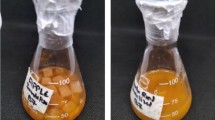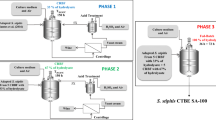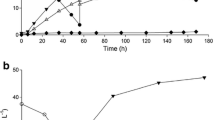Abstract
The aim of this study was to perform the adaptation of Lactobacillus paracasei NRRL B-4564 to substrate through adaptive evolution in order to ensure intensive substrate utilization and enhanced L (+)-lactic acid (LA) production on molasses-enriched potato stillage. To evaluate the strain response to environmental conditions exposed during the adaptation process and to select the best adapted cells, the antioxidant activity and LA-producing capability were assessed in batch fermentation. The most promising adapted strain was further used in a pulsed fed-batch mode. Among three selected adapted strains, L. paracasei A-22 showed considerably improved antioxidant capacity, demonstrating more than onefold higher 2,2-diphenyl-1-picrylhydrazyl (DPPH) radical-scavenging rates compared to parent strain. This strain also exhibited superior LA production in batch fermentation and reached 89.4 g L−1 of LA, with a yield of 0.89 g g−1, a productivity of 1.49 g L−1 h−1, and an optical purity greater than 99%. Furthermore, in fed-batch mode L. paracasei A-22 resulted in 59% higher LA concentration (169.9 g L−1) compared to parent strain (107.1 g L−1). The strain adaptation to molasses environment, performed in this study, is a rather simple and promising method for enhancement of LA production on the complex agro-industrial substrate.





Similar content being viewed by others
References
Madhavan Nampoothiri, K., Nair, N. R., & John, R. P. (2010). An overview of the recent developments in polylactide (PLA) research. Bioresource Technology, 101(22), 8493–8501.
Van De Guchte, M., Serror, P., Chervaux, C., Smokvina, T., Ehrlich, S. D., & Maguin, E. (2002). Stress responses in lactic acid bacteria. Antonie Van Leeuwenhoek, 82(1/4), 187–216.
Zhang, Y., Zhu, Y., Zhu, Y., & Li, Y. (2009). The importance of engineering physiological functionality into microbes. Trends in Biotechnology, 27(12), 664–672.
Zhang, Y., & Li, Y. (2013). Engineering the antioxidative properties of lactic acid bacteria for improving its robustness. Current Opinion in Biotechnology, 24(2), 142–147.
Lushchak, V. I. (2014). Free radicals, reactive oxygen species, oxidative stress and its classification. Chemico-Biological Interactions, 224, 164–175.
Lushchak, V. I. (2011). Adaptive response to oxidative stress: bacteria, fungi, plants and animals. Comparative Biochemistry and Physiology Part C: Toxicology & Pharmacology, 153(2), 175–190.
Dragosits, M., & Mattanovich, D. (2013). Adaptive laboratory evolution – principles and applications for biotechnology. Microbial Cell Factories, 12(1), 64.
Sunwoo, I. Y., Kwon, J. E., Nguyen, T. H., Ra, C. H., Jeong, G. T., & Kim, S. K. (2017). Bioethanol production using waste seaweed obtained from Gwangalli beach, Busan, Korea by co-culture of yeasts with adaptive evolution. Applied Biochemistry and Biotechnology, 183(3), 966–979.
Misra, S., Raghuwanshi, S., & Saxena, R. K. (2013). Evaluation of corncob hemicellulosic hydrolysate for xylitol production by adapted strain of Candida tropicalis. Carbohydrate Polymers, 92(2), 1596–1601.
Tomás-Pejó, E., Ballesteros, M., Oliva, J. M., & Olsson, L. (2010). Adaptation of the xylose fermenting yeast Saccharomyces cerevisiae F12 for improving ethanol production in different fed-batch SSF processes. Journal of Industrial Microbiology and Biotechnology, 37(11), 1211–1220.
Xu, S., Hao, N., Xu, L., Liu, Z., Yan, M., Li, Y., & Ouyang, P. (2015). Series fermentation production of ornithine and succinic acid from cane molasses by Corynebacterium glutamicum. Biochemical Engineering Journal, 99, 177–182.
He, X., Chen, K., Li, Y., Wang, Z., Zhang, H., Qian, J., & Ouyang, P. (2015). Enhanced l-lysine production from pretreated beet molasses by engineered Escherichia coli in fed-batch fermentation. Bioprocess and Biosystems Engineering, 38(8), 1615–1622.
Küçükaşik, F., Kazak, H., Güney, D., Finore, I., Poli, A., Yenigün, O., Nicolaus, B., & Öner, E. T. (2011). Molasses as fermentation substrate for levan production by Halomonas sp. Applied Microbiology and Biotechnology, 89(6), 1729–1740.
Roukas, T. (1998). Pretreatment of beet molasses to increase pullulan production. Process Biochemistry, 33(8), 805–810.
Kotzamanidis, C., Roukas, T., & Skaracis, G. (2002). Optimization of lactic acid production from beet molasses by Lactobacillus delbrueckii NCIMB 8130. World Journal of Microbiology and Biotechnology, 18(5), 441–448.
Lee, J., Lee, S. Y., Park, S., & Middelberg, A. P. (1999). Control of fed-batch fermentations. Biotechnology Advances, 17(1), 29–48.
Abdel-Rahman, M. A., Tashiro, Y., & Sonomoto, K. (2013). Recent advances in lactic acid production by microbial fermentation processes. Biotechnology Advances, 31(6), 877–902.
Hofvendahl, K., & Hahn-Hägerdal, B. (2000). Factors affecting the fermentative lactic acid production from renewable resources1. Enzyme and Microbial Technology, 26(2-4), 87–107.
Li, Z., Lu, J., Zhao, L., Xiao, K., & Tan, T. (2010). Improvement of L-lactic acid production under glucose feedback controlled culture by Lactobacillus rhamnosus. Applied Biochemistry and Biotechnology, 162(6), 1762–1767.
Mladenović, D., Djukić-Vuković, A., Kocić-Tanackov, S., Pejin, J., & Mojović, L. (2016). Lactic acid production on a combined distillery stillage and sugar beet molasses substrate. Journal of Chemical Technology and Biotechnology, 91(9), 2474–2479.
Lin, M. Y., & Yen, C. L. (1999). Antioxidative ability of lactic acid bacteria. Journal of Agricultural and Food Chemistry, 47(4), 1460–1466.
Li, S., Zhao, Y., Zhang, L., Zhang, X., Huang, L., Li, D., Niu, C., Yang, Z., & Wang, Q. (2012). Antioxidant activity of Lactobacillus plantarum strains isolated from traditional Chinese fermented foods. Food Chemistry, 135(3), 1914–1919.
Miller, G. L. (1959). Use of dinitrosalicylic acid reagent for determination of reducing sugar. Analytical Chemistry, 31(3), 426–428.
Barroso, C. G., Rodriguez, M. C., Guillen, D. A., & Perez-Bustamante, J. A. (1996). Analysis of low molecular mass phenolic compounds, furfural and 5-hydroxymethylfurfural in Brandy de Jerez by high-performance liquid chromatography-diode array detection with direct injection. Journal of Chromatography A, 724(1-2), 125–129.
Mishra, V., Shah, C., Mokashe, N., Chavan, R., Yadav, H., & Prajapati, J. (2015). Probiotics as potential antioxidants: a systematic review. Journal of Agricultural and Food Chemistry, 63(14), 3615–3626.
Allen, S. A., Clark, W., McCaffery, J. M., Cai, Z., Lanctot, A., Slininger, P. J., Liu, Z. L., & Gorsich, S. W. (2010). Furfural induces reactive oxygen species accumulation and cellular damage in Saccharomyces cerevisiae. Biotechnology for Biofuels, 3(1), 2.
Solioz, M., Mermod, M., Abicht, H. K., & Mancini, S. (2011). Responses of lactic acid bacteria to heavy metal stress. In E. Tsakalidou & K. Papadimitriou (Eds.), Stress responses of lactic acid bacteria (pp. 163–195). Boston, MA: Springer.
Park, H. S., Um, Y., Sim, S. J., Lee, S. Y., & Woo, H. M. (2015). Transcriptomic analysis of Corynebacterium glutamicum in the response to the toxicity of furfural present in lignocellulosic hydrolysates. Process Biochemistry, 50(3), 347–356.
Taherzadeh, M. J., & Karimi, K. (2011). Fermentation inhibitors in ethanol processes and different strategies to reduce their effects. In: Biofuels: alternative feedstocks and conversion processes (Pandey, A., Larroche, Ch., Ricke, S.C., Dussap, C-G. Gnansounou, E., eds.), Academic Press, pp. 287–311.
Fattohi, N. (1990). Investigation into the presence of volatile secondary constituents of beet molasses with inhibitory effect on yeast fermentation and baker’s yeast quality. Zuckerindustrie, 115(5).
Almeida, J. R., Modig, T., Petersson, A., Hähn-Hägerdal, B., Lidén, G., & Gorwa-Grauslund, M. F. (2007). Increased tolerance and conversion of inhibitors in lignocellulosic hydrolysates by Saccharomyces cerevisiae. Journal of Chemical Technology and Biotechnology, 82(4), 340–349.
de Oliveira, R. A., Rossell, C. E. V., Venus, J., Rabelo, S. C., & Maciel Filho, R. (2018). Detoxification of sugarcane-derived hemicellulosic hydrolysate using a lactic acid producing strain. Journal of Biotechnology, 278, 56–63.
Yi, X., Zhang, P., Sun, J., Tu, Y., Gao, Q., Zhang, J., & Bao, J. (2016). Engineering wild-type robust Pediococcus acidilactici strain for high titer L-and D-lactic acid production from corn stover feedstock. Journal of Biotechnology, 217, 112–121.
Filipčev, B., Mišan, A., Šarić, B., & Šimurina, O. (2016). Sugar beet molasses as an ingredient to enhance the nutritional and functional properties of gluten-free cookies. International Journal of Food Sciences and Nutrition, 67(3), 249–256.
Valli, V., Gómez-Caravaca, A. M., Di Nunzio, M., Danesi, F., Caboni, M. F., & Bordoni, A. (2012). Sugar cane and sugar beet molasses, antioxidant-rich alternatives to refined sugar. Journal of Agricultural and Food Chemistry, 60(51), 12508–12515.
Yang, X., Zhu, M., Huang, X., Lin, C. S. K., Wang, J., & Li, S. (2015). Valorisation of mixed bakery waste in non-sterilized fermentation for L-lactic acid production by an evolved Thermoanaerobacterium sp. strain. Bioresource Technology, 198, 47–54.
Bai, D. M., Li, S. Z., Liu, Z. L., & Cui, Z. F. (2008). Enhanced l-(+)-lactic acid production by an adapted strain of Rhizopus oryzae using corncob hydrolysate. Applied Biochemistry and Biotechnology, 144(1), 79–85.
Peinemann, J. C., & Pleissner, D. (2018). Material utilization of organic residues. Applied Biochemistry and Biotechnology, 184(2), 733–745.
Djukić-Vuković, A., Mojović, L., Vukašinović-Sekulić, M., Nikolić, S., & Pejin, J. (2013). Integrated production of lactic acid and biomass on distillery stillage. Bioprocess and Biosystems Engineering, 36(9), 1157–1164.
Marques, S., Gírio, F. M., Santos, J. A. L., & Roseiro, J. C. (2017). Pulsed fed-batch strategy towards intensified process for lactic acid production using recycled paper sludge. Biomass Conversion and Biorefinery, 7(2), 127–137.
Ouyang, J., Ma, R., Zheng, Z., Cai, C., Zhang, M., & Jiang, T. (2013). Open fermentative production of L-lactic acid by Bacillus sp. strain NL01 using lignocellulosic hydrolyzates as low-cost raw material. Bioresource Technology, 135, 475–480.
Wang, L., Zhao, B., Liu, B., Yu, B., Ma, C., Su, F., Hua, D., Li, Q., Ma, Y., & Xu, P. (2010). Efficient production of L-lactic acid from corncob molasses, a waste by-product in xylitol production, by a newly isolated xylose utilizing Bacillus sp. strain. Bioresource Technology, 101(20), 7908–7915.
Hu, J., Zhang, Z., Lin, Y., Zhao, S., Mei, Y., Liang, Y., & Peng, N. (2015). High-titer lactic acid production from NaOH-pretreated corn stover by Bacillus coagulans LA204 using fed-batch simultaneous saccharification and fermentation under non-sterile condition. Bioresource Technology, 182, 251–257.
Ge, X. Y., Qian, H., & Zhang, W. G. (2009). Improvement of l-lactic acid production from Jerusalem artichoke tubers by mixed culture of Aspergillus niger and Lactobacillus sp. Bioresource Technology, 100(5), 1872–1874.
Wang, L., Zhao, B., Li, F., Xu, K., Ma, C., Tao, F., Li, Q., & Xu, P. (2011). Highly efficient production of d-lactate by Sporolactobacillus sp. CASD with simultaneous enzymatic hydrolysis of peanut meal. Applied Microbiology and Biotechnology, 89(4), 1009–1017.
Xu, K., & Xu, P. (2014). Efficient production of L-lactic acid using co-feeding strategy based on cane molasses/glucose carbon sources. Bioresource Technology, 153, 23–29.
Zhang, Y., & Vadlani, P. V. (2013). D-lactic acid biosynthesis from biomass-derived sugars via Lactobacillus delbrueckii fermentation. Bioprocess and Biosystems Engineering, 36(12), 1897–1904.
Cheng, X., Dong, Y., Su, P., & Xiao, X. (2014). Improvement of the fermentative activity of lactic acid bacteria starter culture by the addition of Mn2+. Applied Biochemistry and Biotechnology, 174(5), 1752–1760.
Acknowledgements
Authors acknowledge Milica Carević, PhD, for help in HPLC analysis.
Funding
Research presented in this paper was funded by the Ministry of Education, Science and Technological Development, Republic of Serbia, project number TR 31017 and Scientific Project#1 between People’s Republic of China and the Republic of Serbia 2017–2019.
Author information
Authors and Affiliations
Corresponding author
Ethics declarations
Conflict of Interest
The authors declare that they have no conflicts of interest.
Rights and permissions
About this article
Cite this article
Mladenović, D., Pejin, J., Kocić-Tanackov, S. et al. Enhanced Lactic Acid Production by Adaptive Evolution of Lactobacillus paracasei on Agro-industrial Substrate. Appl Biochem Biotechnol 187, 753–769 (2019). https://doi.org/10.1007/s12010-018-2852-x
Received:
Accepted:
Published:
Issue Date:
DOI: https://doi.org/10.1007/s12010-018-2852-x




